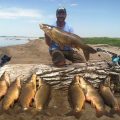The popularity of bowfishing seems to peak and trough in five- to 10-year cycles, especially regionally. When I was a kid in the Southwest, for example, we were looked upon oddly for bowfishing for the local carp. But by the time I was in collage bowfishing became all the rage, with a bowfishing tournament occurring nearly every other weekend through the spring and summer. Where I now live in northern Idaho—where, yes, we have carp—there are a handful of diehards, but bowfishing isn’t a big thing.


You don’t have to follow trends to enjoy the great off-season sport of bowfishing. You can be the one eliciting the odd stares and answering the questions about its legality. And yes, it is legal nearly everywhere, as long as the targets are so-called trash fish such as Asian carp (which are also an invasive species harmful to native fish species), buffalofish, suckers and various gar, saltwater stingrays, any several others. Even in the arid Southwest we found bowfishing opportunities on our local rivers and lakes. There is no more fun way to spend a hot spring or summer day than wading or boating local waters and sending arrows through less desirable nongame fish.
The best thing about bowfishing is it can be made as complicated or as simple as you wish. The simple approach is to purchase a basic drum reel kit and wade into the edges of a local water or walk its banks, looking for fish to stalk. Others rig out bowfishing battle boats, including power generators and lights for nighttime assaults, and invest in more sophisticated gear for deeper waters or bigger game.
A basic list of bowfishing gear includes a pawn shop bow you don’t mind getting wet and muddy, bowfishing reel to hold and pay out stout line, bowfishing-specific arrow and point, bowfishing rest to support the heavy fishing arrow, polarized sunglasses and ratty clothes you don’t mind subjecting to mud and fish scales.


The bowfishing bow can be anything from a simple recurve or longbow to a quality compound. I prefer the traditional bow approach, as it is better suited to quick snap shots in shallow water. The primitive wood bow will accept a basic tape-on drum reel, while a modern milled-aluminum riser recurve includes taps for more sophisticated reel styles. Bowfishing-specific compounds are offered, though any old compound will do if draw weight is kept to 50 pounds or less for safety reasons.
The bowfishing reel ranges from a basic drum arrangement to heavy-duty spin-casting reels set on a reel seat or seat with short rod to the AMS Retriever bottle reel system. Drum reels come in tape-on or stabilizer-mount models, require hand winding line and include relatively short range capabilities. They are fine for most shallow-water wading, like when targeting spawning carp, but tend to be the slowest approach to follow-up shots. Many prefer the speed of a spinning-reel setup, as the arrow can be retrieved very quickly for faster follow-up shots. The only downside is you must remember to depress the “cast” button before every shot. AMS bottle reels allow fast follow-up, and do not require pressing a button before every shot. They generally impart less drag on the arrow and line, allowing longer shots in deeper water.


The bowfishing arrow by necessity is quite heavy, usually made from solid fiberglass. This added weight allows it to penetrate deep water, and boney, scaled fish. Its solid construction allows it to stand up to punishing rocks or logs. The point it carries should include barbs, so skewered fish do not slip off the arrow after a hit. Price is dependent on how easily these barbs or removed or reversed to remove fish form the arrow after a successful shot. The heavy mass of the fishing arrow will also require a heavy-duty rest, price dependent on features like rollers or Whisker Biscuit-style bristles. The sunglasses you will need to see beneath the surface glare of the water, polarized fishing glasses mandatory in this respect.
I generally have the most fun wading shallows or ponds, lakes or rivers, or walking irrigation ditch or lake edges targeting spawning carp. Common carp spawn in April to May, depending on latitude, and become downright suicidal while doing so. You will see their backs coming out of the water, a lot of splashing and rolling, and even fish swimming between your legs. This allows the most basic of bowfishing gear, including drum reels and traditional bows, and is a great way to get a kid hooked on bowhunting, as success is nearly assured.
The more sophisticated gear, including more powerful compound bows, come into play in deeper waters where wading opportunities are limited or nearly nonexistent. These types of waters normally result in deeper and/or longer shots, where less drag and more energy are net positives. This can also lead to larger fish, such as trophy carp and buffalofish, or alligator gars weighing up to 150 pounds. Just remember on those deeper shots, water refraction will make targets appear higher in the water than reality, so aim low. How low depends on depth and angle and comes with practice.


Names to remember in this bowfishing gear game include AMS Bowfishing, Fin Finder, Cajun Archery (Bear Archery) and Muzzy (Feradyne).
One thing is for certain, once you begin enjoying some bowfishing success you will find it to be utterly addicting. I never have understood the peaks and troughs of bowfishing’s popularity, as since my first small-creek carp with a cheap recurve, homemade reel and arrow and some scrounged surveying line, I’ve never been able to get enough. When weather turns hot and carp begin wandering into the shallows, there is no better place to be then in cooling water!


